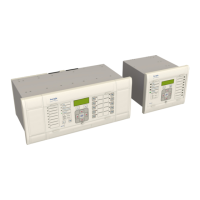
 Loading...
Loading...
Do you have a question about the GE P642 and is the answer not in the manual?
Details the capabilities and models within the MiCOM P64x range of devices.
Outlines personnel qualifications and general safety practices for operating the equipment.
Covers hazards related to lifting, electrical safety, and general installation procedures.
Explains the processing of protection elements and measurement functions by the software.
Details how to navigate menus, change settings, and use keypad functions via the HMI.
Explains how to configure communication settings for various protocols like Courier, DNP3, IEC 60870-5-103, Modbus, and IEC 61850.
Explains the current differential principle, through-fault stability, and bias current compensation.
Details defining the power transformer, selecting current inputs, phase correction, and ratio correction.
Details thermal overload protection, including the thermal model and bias current calculations.
Explains the implementation and calculation of loss of life statistics based on thermal models.
Explains winding-to-core faults and the principles of REF protection for delta and star windings.
Details enabling REF protection, selecting current inputs, and low/high impedance REF principles.
Explains the job of IEDs in protecting power systems from faults and IDMT characteristics.
Details phase overcurrent protection implementation, including stages and directional elements.
Explains the use of negative sequence overcurrent elements for unbalanced fault conditions.
Explains the role of CBF protection in monitoring circuit breakers and ensuring fault isolation.
Provides setting guidelines for CB Fail timers and undercurrent elements.
Details undervoltage conditions and their implementation and logic.
Explains overvoltage conditions, implementation, logic, and setting guidelines.
Explains overfluxing conditions, implementation, logic, and setting guidelines.
Details underfrequency and overfrequency protection implementation and logic.
Details the VTS function for detecting AC voltage input failures and blocking dependent protection.
Explains CTS function for detecting AC current input failures and its impact on protection.
Describes TCS schemes for supervising trip coil and trip path status.
Lists supported data protocols including Courier, MODBUS, IEC 60870-5-103, DNP 3.0, and IEC 61850.
Details current cyber-security measures at IED and external levels.
Details product checks to ensure no physical damage, correct functionality, and tolerance compliance.
Covers periodic checks, alarm status, opto-isolators, output relays, and measurement accuracy.
Guides on identifying error conditions, power-up errors, and mal-operation during testing.
Provides accuracy specifications for transformer differential protection and monitoring functions.
Details accuracy specifications for overcurrent, directional, and negative sequence protection.
Specifies accuracy for undervoltage, overvoltage, residual overvoltage, and negative sequence voltage protection.